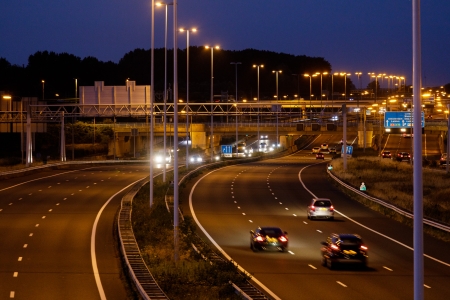Apart from the numerous advantages of public lighting, there are also a few disadvantages.
Lamp posts as collision objects
Public lighting may have a negative effect on road safety since lighting colums could be collision objects. Annually, Dutch police register 16 fatal accidents on account of a collision with a lamp post. In 71% of these accidents, a car collides with the lamp post. The share of fatal accidents involving lamp posts in the total number of fatal accidents is largest for motor cycles, see Figure 1. With this in mind, it is advisable to position the lighting colums as far away from the carriageway as possible; from a lighting-technical point of view, however, the light source should not be positioned too far away from the carriageway.
 Figure 1. The share of registered fatal accidents involving lamp posts in the total number of registered fatal accidents per transport mode in 2007-2016, per transport mode (Source: IenW).
Figure 1. The share of registered fatal accidents involving lamp posts in the total number of registered fatal accidents per transport mode in 2007-2016, per transport mode (Source: IenW).
Crash-friendly lighting colums may reduce the severity of collisions with lighting colums [1] [10]. A crash-friendly lamp post is constructed in such a way that it offers little resistance and breaks away when a vehicle crashes into it. On motorways, crash-friendly lighting colums reduce the risk of personal injury crashes by 50% [2]. A crash-friendly lamp post can therefore be positioned without safety barriers within an obstacle-free zone [11] [12]. A crash-friendly lamp post does need to be positioned in such a way as to cause no further damage after a collapse [10]. A crash-friendly lamp post has, however, been designed for cars and will therefore have little effect on the number of motorcyclists that die after a crash involving a lamp post.
Carbon footprint
According to the Government Energy Platform (an independent library portal about governmental energy policies), public lighting in the Netherlands amounted to approximately 1.5% of all electric lighting produced in 2014 [13]. The 2013 Dutch Energy Agreement states that, in comparison to 2013, the Netherlands aim to have saved 20% in energy needed for public lighting by 2020, and 50% by 2030. This may be achieved by replacing at least 40% of present lighting by LED lighting.
Light pollution: impact on plants, animals and people
Plant growth may be disrupted by lighting. The germination, pollination and bloom of certain plants (e.g. hops) may be disturbed by artificial light at night. Public lighting may disturb the biorhythm of animals (day and night or annual rhythm), may attract animals to places where they may be overrun or may scare away animals from potential breeding grounds or nesting places [14]. Human day and night rhythm may also be disturbed by public lighting.
Costs and cost effectiveness
Of course, public lighting involves costs. Think of material, maintenance and energy costs. A measure is cost effective when the benefits (road safety benefits) outweigh these costs. Dutch research proves that, on most Dutch roads, public lighting is cost effective as far as lower illuminance levels and cheaper installations are concerned [15]. Moreover, it appears that an increase of illuminance levels is effective within urban areas, whereas it is not in rural areas. Norwegian data show that illuminating roads that were previously unlit is cost effective on most roads (with the exception of motorways) with a minimum traffic volume of 15.000 vehicles a day [2].
